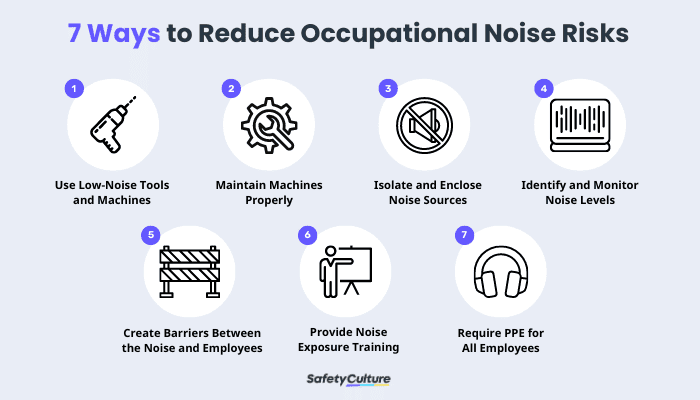What is Occupational Noise Exposure?
Occupational noise exposure refers to the amount of noise that employees are exposed to or experience during regular operations. According to the Occupational Safety and Health Administration (OSHA), over 30 million Americans are exposed to hazardous noise each year which can lead to hearing damage and other complications. This is why it’s important to find ways to reduce the risk associated with occupational noise exposure to keep employees safe.
There are many industries wherein employees are exposed to hazardous noises. Some of the most common professions that deal with occupational noise exposure include:
- Military
- Mining
- Agriculture
- Plumbing
- Construction
Many other industries deal with occupational noise exposure, but those are some of the most common professions wherein people experience unsafe levels of noise.
What is Occupational Noise?
Occupational noise is any type of noise one might experience in the workplace. For example, it can be the sounds from operating a jackhammer, being around explosive blasts, gunshots, jets taking off, or even trucks moving. When managing an organization, it’s important to account for possible occupational noise exposure to protect employees from the hazards of excessive noise exposure.
What are the Dangers of Excessive Noise Exposure?
While certain industries have to deal with more occupational noise than others, all organizations need to be concerned about it. This is because the human ears are sensitive and excessive exposure to this noise may cause a range of health concerns.
The most common risk of excessive noise exposure is developing tinnitus or hearing loss. Hearing loss and tinnitus as a result of occupational noise is commonly reported among flight crews, farmers, military personnel, musicians, bartenders, and many other professions.
It is completely on the organization to assess the levels of occupational noise that their employees are exposed to and ensure that noise levels are always safe. And if employees must be exposed to excessive noise, it’s important for managers to place controls to mitigate the risks associated with excessive noise exposure.
OSHA’s Noise Standard
The United States OSHA has a standard in place to address occupational noise and ensure the safety of employees, especially when in loud environments. These standards set legal limits on noise exposure in the workplace.
The limits in this standard are based on a time-weighted average of an 8-hour day. And according to the standard, the permissible limit for noise exposure in the workplace is 90 dBA for an 8-hour day. Anything more than that is considered a risk for employees.
The standard also requires employers to implement a hearing conservation program if noise levels are above 85 dBA in an 8-hour day. Examples of how you can implement one of these programs include requiring employees to wear Personal Protective Equipment (PPE) such as earplugs, providing free hearing exams, monitoring noise levels, and more.
Reducing the Risk of Occupational Noise
There are many ways employers can reduce the risk of occupational noise. The majority of these methods require you to reduce noise exposure or noise levels entirely. Some of the ways that organizations may reduce occupational noise in the workplace could be:

- Using low-noise tools and machinery
- Maintaining machines properly so they operate quietly
- Isolating and enclosing noise sources
- Identifying and constantly monitoring noise levels through noise risk assessments
- Creating barriers between the noise and your employees
- Training employees to recognize and avoid hazardous noise exposure
- Requiring employees to wear PPE when there’s a risk of noise exposure
The methods your organization uses when reducing occupational noise largely vary on how you operate and the type of noise employees are commonly exposed to. While OSHA has standards on how employers can reduce the risks of occupational noise, it’s important to tailor these methods according to your employees’ needs.
Create Your Own Noise Risk Assessment Template
Eliminate manual tasks and streamline your operations.
Get started for FREEFAQs about Occupational Noise Exposure
OSHA has a standard on occupational noise exposure designed to reduce the risks of employees being exposed to hazardous levels of noise exposure. This standard includes measuring and monitoring noise levels as well as placing controls to limit exposure to hazardous noise.
There are many ways to control occupational noise. Ideally, noise controls in a workplace need to be tailored to the needs of the employees. Some methods for suppressing noise involve isolating the source, buying quiet machinery, maintaining machinery, and requiring employees to wear hearing protectors when working in loud environments.
Yes, loud noises are an occupational health hazard. There are millions of workers that report hearing loss and tinnitus as a result of prolonged and repeated exposure to hazardous noise levels. This is why employers are responsible for ensuring that employees aren’t exposed to high levels of noise.
Some common examples of dangerous occupational noises are the sound of:
- jet engines;
- jackhammers;
- hammering;
- loudspeakers;
- explosions;
- gunshots;
- drilling rigs; and
- large vehicles moving around.




